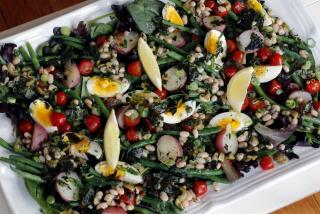Good Eating for Good Health
- Share via
Turn on your TV, open a newspaper, or boot up your computer and you’re bound to get some confusing news about diet and health. Don’t let it drive you to distraction -- or to the donut shop. Instead, remember four key facts:
What you eat affects your appearance, your energy and comfort, and -- above all -- your health.
America is on the wrong track. Two out of every three of us are overweight or obese. Diabetes and high blood pressure are on the rise. Many factors contribute to these complex problems, but the basic reasons are simple: We eat too much, we choose the wrong foods, and we don’t get enough exercise.
Scientists know what diet is best for health. The fine print has changed and is likely to change some more, but the key facts are in.
Good eating is not a punishment, but an opportunity. If you know why it’s important and what to do, you’ll find it enjoyable and satisfying.
THE BEST DIET
People don’t eat nutrients, they eat food. Here are 20 guidelines for healthful and enjoyable eating:
1. Eat a variety of foods; since no single food is perfect, you need a balanced mix of foods to get all the nutrients your body requires.
2. Eat more vegetable products and fewer animal products.
3. Eat more fresh and homemade foods and fewer processed foods. Avoid fast food and junk food.
4. Choose your fats wisely. Cut down on meat, the skin of poultry, whole-fat dairy products, stick margarine, fried foods, processed snack foods, and commercial baked goods made with trans fat. Use olive or canola oil to cook whenever possible, and moisten your bread with olive oil or soft margarine.
5. Choose your carbs wisely. Cut down on simple sugars; remember that sodas, sports energy drinks, and fruit juices are loaded with sugar. Cut down on highly refined products made with white flour. Favor whole-grain, coarsely ground, unrefined products.
6. Consume at least three cups of non- or low-fat dairy products a day.
7. Eat protein in moderation. Favor fish and skinless poultry. Experiment with soy and beans as a protein source.
8. Restrict your sodium intake to less than 2,300 mg per day, particularly if your blood pressure is borderline or high, by reducing your use of table salt and processed foods such as canned soup and juices, luncheon meats, condiments, frozen dinners, cheese, tomato sauce, and snack foods.
9. Eat more potassium-rich foods, such as citrus fruits, bananas, and other fruits and vegetables. Eat more calcium-rich foods such as low-fat dairy products, broccoli, spinach, and tofu (but don’t take calcium supplements to boost your daily intake above 1,200 mg).
10. Eat more grain products, especially whole-grain products, aiming for at least 6 ounces a day. Count one cup of dry cereal; ½ cup of cooked cereal, rice, or pasta; or one slice of bread as 1 ounce.
11. Eat more vegetables, especially deep-green and yellow-orange vegetables. Aim for at least five servings a day.
12. Eat more fruits, aiming for at least four servings a day. Count one medium-size piece of fruit; ½ cup of fresh, frozen, or canned fruit; or ½ cup of fruit juice as one portion.
13. Eat more fish, aiming for at least two 4-ounce servings each week. Remember to broil, bake, or grill instead of frying.
14. If you choose to eat red meat, try to reduce your intake to two 4-ounce servings per week. Avoid “prime” and other fatty meats, processed meats, and liver. Switch to chicken and turkey, always removing the skin.
15. Eat eggs sparingly; aim for an average of no more than one egg yolk per day, including those used in cooking and baking. Use egg substitutes whenever possible.
16. Include seeds and unsalted nuts in your diet. Nuts have been linked to a reduced risk of cardiac death, but since they are high in calories, moderation is the watchword.
17. Use vegetable oils in moderation, favoring olive and canola oils. Reduce your intake of partially hydrogenated vegetable oils, palm oil, and coconut milk.
18. If you choose to use alcohol, drink sparingly. Men should not average more than two drinks per day, women one a day.
19. Adjust your caloric intake and exercise level to maintain a desirable body weight. If you need to reduce, aim for gradual weight loss by lowering your caloric intake and increasing your exercise level.
20. Avoid fad diets and extreme or unconventional nutritional schemes. If it’s too good to be true, it’s not true.
(C) 2009. PRESIDENT AND FELLOWS OF HARVARD COLLGE. ALL RIGHTS RESERVED DISTRIBUTED BY TRIBUNE MEDIA SERVICES, INC.
More to Read
The biggest entertainment stories
Get our big stories about Hollywood, film, television, music, arts, culture and more right in your inbox as soon as they publish.
You may occasionally receive promotional content from the Los Angeles Times.










